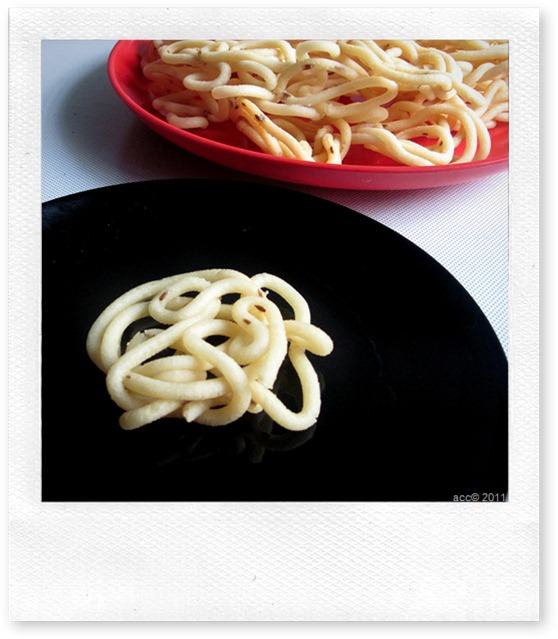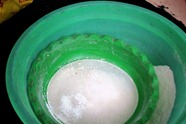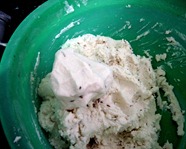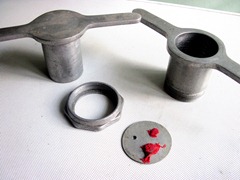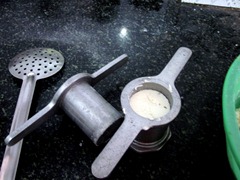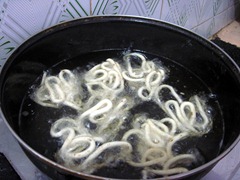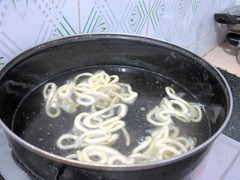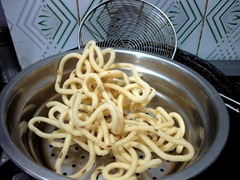 |
| Sarabeth's Bakery Currant Scones with homemade strawberry jam |
In part 1, my friend, Ann, and I tasted scones at Brown's Hotel, in London, and then made them with some friends in an English kitchen. When I got home, I wanted to see how well the recipe would work with American ingredients and equipment. I wasn't surprised to find that the recipe did not work well, as Ann had told me that she hadn't had much luck using her American recipes in Britain. Most likely, the recipe didn't work well because the flour is different, but the butter and milk might have contributed too. I was a little surprised that the scones didn't brown in my oven at home, but then the temperature that Brown's scones cooks at is much lower than any other recipes I've seen, both English and American.

For my first try, I used my everyday flour, King Arthur unbleached all-purpose flour. I found that the dough was so dry that I had to add an extra 2-3 tablespoons of milk to even get it to come together. For the second attempt, I used Pillsbury bleached all-purpose flour, which has less protein in it than the King Arthur flour. I did find that switching to this flour worked better. At least I didn't have to add so much extra liquid to get the dough to the proper texture. However, the scones rose much higher than Brown's scones, and because of this they didn't look as pretty (bleached flour is probably the cause of this). I also think I overkneaded this batch of dough in an effort to get the dough 'smooth', an instruction in Chef Ecuvillon's recipe (which I didn't do in London). Although they weren't tough, they didn't have the delicate texture found in the original Brown's scone. If I made these scones again, I would probably try them with biscuit flour (White Lily, Southern Biscuit, or King Arthur Perfect Pastry Flour), and would knead them lightly, as I had done in London.
For my next experiment I tried America's Test Kitchen Dreamy Cream Scones. This recipe is very similar to the Brown's recipe except that the butter doesn't get cut in as finely, it has more baking powder and cream instead of milk. The disadvantage to having more baking powder is that the scones rise higher and don't look as pretty. The texture is quite different because of the handling of the butter and the larger amount of baking powder. These were delicious but tasted more like ordinary biscuits, rather than th emore exotic scone!
Next, I tried Sarabeth's Bakery Currant Scones. These are extremely different from the two above, because they contain eggs and they have very little sugar in them. They were quite flaky and they cooked perfectly, with the oven starting out very hot, and then being reduced when the scones were in. The only problem with these was that they weren't sweet enough to suit my husband.
The last batch that I made, was from the Joy of Cooking. I made their classic scones, but instead of using egg I used double the amount of cream (as per variation in the Joy). This was the scone that we liked the most. These were the flakiest of all, crusty on the outside, yet moist within, and sweet enough to suit my husband's tastes. You'll see that they're not as shiny as Sarabeth's because the glaze is just a light brushing of cream, rather than the shine of an egg. Although they're not as pretty, we liked the taste of the crust better without the egg wash.
For the original Joy of Cooking recipe, please see The All New Joy of Cooking Classic Currant Scones. The recipe below has been slightly altered by me. Brown's Hotel Scones (adjusted for American kitchens) follows. For Sarabeth's, go to
http://www.epicurious.com/ and look for the recipe that was printed in Gourmet Magazine in 2010.
The All New Joy of Cooking Classic Currant Scones, edited by Penny EisenbergMakes 8 wedges or about 20 round scones
2 cups (260 grams) all-purpose flour, fluffed scooped and levelled
3-5 tablespoons sugar, to taste
2-1/2 teaspoons baking powder (can use up to 1 tablespoon)
1/2 teaspoon salt
6 tablespoons (3 ounces) unsalted butter, cold
1/2 cup dried currants or raisins
1 cup heavy cream + 1 tablespoon, divided, cold
Preheat the oven to 425 degrees F. Line a baking sheet with parchment paper.
In a large bowl, whisk together the flour, sugar, baking powder and salt.
Either cut the butter into small pieces, or grate the butter on the large grate of a box cutter.
Toss the butter into the flour mixture to separate the pieces. If using cut butter (rather than grated) you will need to rub the butter into the flour with your fingertips or use a pastry blender to cut the butter in until the largest pieces are the size of peas, and the rest looks like breadcrumbs. Work quickly and lightly.
Stir in the currants or raisins. Make a well in the flour mixture and pour in the cream, all at once. Mix with a rubber spatula or wooden spoon until the dry ingredients are moistened.
Knead the dough, lightly, turning the dough and pressing it until everything adheres together. Gently roll the dough into an 8-inch round, about 3/4-inch thick.
Cut the dough into 8 wedges, or cut out rounds with a 2t o 2-1/2-inch floured biscuit cutter. Place the scones on the parchment paper, at least 1/2-inch apart. Brush the tops of the scones with cream. If desired sprinkle with coarse sugar. Place in the oven and immediately reduce the oven temperature to 400 degrees. F. Bake for 12-15 minutes until golden. Let cool on a rack, and serve slightly warm or at room temperature.
Brown's Hotel Scones adapted for the American Kitchen
Makes 16 wedges or 20 small round scones
4 cups minus 2 tablespoons (500 grams) lower-protein all-purpose (such as Pillsbury or Gold Medal), fluffed, scooped and levelled (if using biscuit flour, you might need 1/4-1/3 cup more flour)
4 teaspoons baking powder
1/4 teaspoon salt
7 tablespoons unsalted butter, cold
1/2 cup sugar
1/4 cup raisins or sultanas
1 cup whole milk + 2 tablespoons, divided
For egg wash
2 large egg yolks
1 tablespoon whole milk
pinch sugar
In a large bowl, whisk together the flour, baking powder and salt. Either dice the butter, or grate it on a box grater (see above). Add the butter to the flour mixture, and using your fingertips, rub the butter into the flour until it is no longer visible. Stir in the sugar.
Toss the sultanas into the above mixture. Make a well in the mixture and pour in all of the milk. Stir with a spoon until the mixture starts to come together.
Turn the mixture onto a lightly floured surface, and knead gently, 5 or 6 times, until it forms a smooth, soft dough (add a little more flour or milk to get the texture right). Form into a round, wrap in cling wrap and chill for 1 hour.
Preheat the oven to 400 degrees F. Line two baking sheets with parchment paper. Roll the dough gently on a floured surface to about 1-inch. thick. Dip a 2-inch round cookie cutter into flour, and then cut out the rounds, dipping the cutter as needed. Press together scraps and re-cut. Place the rounds on the parchment paper. Alternatively you can shape the dough into two 8-inch rounds and then cut each into 8 wedges.
Make the egg wash, by mixing the ingredients together in a small bowl. Brush the tops of the scones with the egg wash.
Bake for 8-10 minutes, until the scones are golden brown and look and feel cooked on the sides. Let the scones cool until just barely warm or completely cooled, and serve with fresh strawberry jam. You probably won't be able to make Clotted Cream because you need unpasteurized or lightly pasteurized cream to make it, but you might be able to find jarred Devonshire Cream in a specialty food store.
![]() .I saw so many thenkuzhal recipes in web with different proportions of rice and urad dal . I want to share my version.I tried to take step by step pics for beginners. I really admire our fellow bloggers who blog recipes with step by step pics for each and every post. They have so much of patience and skill to do this. I really don't have both
.I saw so many thenkuzhal recipes in web with different proportions of rice and urad dal . I want to share my version.I tried to take step by step pics for beginners. I really admire our fellow bloggers who blog recipes with step by step pics for each and every post. They have so much of patience and skill to do this. I really don't have both ![]() .For sweets and savouries step by step presentation is most essential i feel. Hope this post helps beginners. Feel free to leave ur comments about my presentation.I will improve in my further posts. Now coming to my version..
.For sweets and savouries step by step presentation is most essential i feel. Hope this post helps beginners. Feel free to leave ur comments about my presentation.I will improve in my further posts. Now coming to my version..![]() . Catch u in my next post. Bye. Have a gr8 weekend
. Catch u in my next post. Bye. Have a gr8 weekend ![]()
